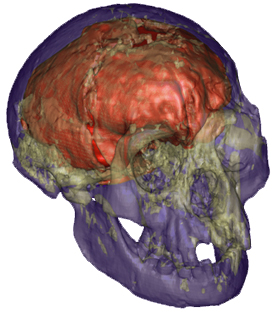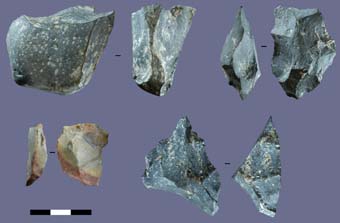|
A recent study supports the discovery of a new Hobbit-like species that lived 12,000 years ago.
by Liz Quinn
 Courtesy of Kirk E. Smith, Mallinckrodt Institute of Radiology at Washington University School of Medicine
Courtesy of Kirk E. Smith, Mallinckrodt Institute of Radiology at Washington University School of Medicine
Virtual model
of the Hobbit's brain encased in a transparent image of
its skull.
|
|
In 2004, the remains of ancient, Hobbit-like
people were found on the island of Flores in Indonesia. The discovery
was made by Australian archaeologists who claimed that these people
represented a new branch in the human family tree and called them
Homo floresiensis. Some hailed this as the most significant
fossil discovery in a century, but a few scientists disagreed -
claiming that they weren't a new species but merely modern humans
with microencephaly, a congenital disorder that stunts brain growth.
Recently, a team of researchers from
Australian National University lead by Adam Brumm published a paper
in Nature supporting the view that the Hobbit is a new species.
They have linked flint tools found on the island to the Hobbit species,
showing that they were not humans with a brain disease but people
with a unique culture and the ability to make tools despite their
small brain.
This skill may have been passed down to the Hobbit from its ancestors. Homo floresiensis (who existed 70,000 to 12,000 years ago) appears to be the descendant of an unknown species that became isolated in Flores over 800,000 years ago and made stone tools. The large number of flints found directly associated with the hobbit are the same as those found at the 850,000 year old Mata Menge site in central Flores where their ancestors lived. "This suggests that hominids on Flores were making the same kinds of tools on the island for hundreds of thousands of years," Brumm says.
But there is some debate as to whether the tools are really the work of the Hobbit. Some scientists claim that the Hobbit and modern humans (Homo sapiens) could have co-existed on the island for over 30,000 years - and hence that the tools could have been crafted by our own species.
 Courtesy of Mark Moore
Courtesy of Mark Moore
Stone tools dating back to 840,000 years ago found at Mata Menge on the island of Flores.
|
Mike Morwood, one of the archaeologists
who discovered the Hobbit species, disagrees. He claims that modern
humans first appeared on the island around 11,000 years ago, which
is after the Hobbit became extinct. This suggests that it was not
possible for more advanced humans to have made the tools and that
the Hobbit species most likely continued making similar stone flints
to their ancestors. "The brain of the Hobbit is similar in size
to that of Homo habilis that lived in Africa about two million
years ago, and that species also made stone tools," Morwood says.
Another team of scientists have analyzed
the Hobbit's skull and created virtual models of its brain, concluding
that despite its small size, it had some advanced morphological
features. The researchers, including Dean Falk, an expert on brain
evolution from Florida State University, produced the model based
on the negative imprint of the outside surface of the Hobbit's brain
which was present in skulls. The print indicated unusual development
in the frontal part of the brain that is associated with planning
behavior in modern humans, so it may be that it is not the overall
size of the brain that is important for tool-making but rather,
the complexity of the brain's internal 'wiring'.
The new research by Brumm and his colleagues
does support previous arguments that the Hobbit species is a result
of long-term adaptation and evolution on Flores. According to Morwood,
human species reached south-east Asia two million years ago. He
thinks that the Hobbit isn't the only new homonid species in the
area and that other new human species will be discovered on nearby
islands.
For more information:
National Geographic News - "Hobbit" Island Tools Predate Modern Humans, Study Says
http://news.nationalgeographic.com/news/2006/05/060531-hobbits.html
BBC News - New twist in 'hobbit' human story
http://news.bbc.co.uk/1/hi/sci/tech/5021214.stm
|
